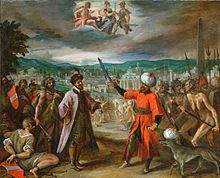Long Turkish War
The Long Turkish War or Thirteen Years' War was an indecisive land war between the Habsburg Monarchy and the Ottoman Empire, primarily over the Principalities of Wallachia, Transylvania and Moldavia.[7] It was waged from 1593 to 1606 but in Europe it is sometimes called the Fifteen Years War, reckoning from the 1591–92 Turkish campaign that captured Bihać.
In the series of Ottoman wars in Europe it was the major test of force between the Ottoman–Venetian War (1570–73) and the Cretan War (1645–69). The next of the major Ottoman-Habsburg wars was the Austro-Turkish War of 1663-1664. Overall, the conflict consisted in a great number of costly battles and sieges, but with very little result for either side.
Overview
The major participants of the war were the Habsburg Monarchy, the Principality of Transylvania, Wallachia and Moldavia opposing the Ottoman Empire. Ferrara, Tuscany, Mantua and the Papal State were also involved to a lesser extent.
Prelude
Skirmishes along the Habsburg–Ottoman border intensified from 1591. In 1592, the fort of Bihać fell to the Ottomans following the Siege of Bihać (1592).
History
1593
In the spring of 1593, Ottoman forces from the Eyalet of Bosnia laid siege to the city of Sisak in Croatia, starting the Battle of Sisak that eventually ended in a victory for the Christian forces on June 22, 1593. That victory marked the end of the Hundred Years' Croatian–Ottoman War (1493-1593).
The war started on July 29, 1593, when the Ottoman army under Sinan Pasha launched a campaign against the Habsburg Monarchy and captured Győr (Turkish: Yanıkkale) and Komarom (Turkish: Komaron) in 1594.
1594
In early 1594, the Serbs in Banat rose up against the Ottomans.[8] The rebels had, in the character of a holy war, carried war flags with the icon of Saint Sava.[9] The war banners were consecrated by Patriarch Jovan Kantul, and the uprising was aided by Serbian Orthodox metropolitans Rufim Njeguš of Cetinje and Visarion of Trebinje.[10] In response, Ottoman Grand Vizier Koca Sinan Pasha demanded that the green flag of the Prophet Muhammed be brought from Damascus to counter the Serb flag and ordered that the sarcophagus containing the relics of Saint Sava be removed from the Mileševa monastery and transferred to Belgrade via military convoy.[9] Along the way, the Ottoman convoy killed all the people in its path as a warning to the rebels.[9] The Ottomans publicly incinerated the relics of Saint Sava on a pyre atop the Vračar plateau on April 27 and had the ashes scattered.[9]
1595–96
In 1595, an alliance of Christian European powers was organized by Pope Clement VIII to oppose the Ottoman Empire (the Holy League of Pope Clement VIII); a treaty of alliance was signed in Prague by the Holy Roman Emperor, Rudolf II and Sigismund Báthory of Transylvania. Aron Vodă of Moldavia and Michael the Brave of Wallachia joined the alliance later that year. The Spanish Habsburgs sent an army of 6,000 experienced infantry and 2,000 cavalry from the Netherlands under Karl von Mansfeld, commander in chief of the Spanish Army of Flanders, who took the command of the operations in Hungary.[11]
The Ottomans' objective of the war was to seize Vienna, while the Habsburg Monarchy wanted to recapture the central territories of the Kingdom of Hungary controlled by the Ottoman Empire. Control over the Danube line and possession of the fortresses located there was crucial. The war was mainly fought in Royal Hungary (mostly present day western Hungary and southern Slovakia), Transdanubia, Royal Croatia and Slavonia, the Ottoman Empire (Rumelia – present day Bulgaria and Serbia), and Wallachia (in present-day southern Romania).
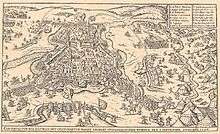
In 1595, the Christians, led by Mansfeld, captured Esztergom and Visegrád, strategic fortresses on the Danube, but they did not engage in the siege of the key fortress of Buda. The Ottomans launched a siege of Eger (Turkish: Eğri), conquering it in 1596.
On the Balkans, in 1595 a Spanish fleet of galleys from Naples and Sicily under Pedro de Toledo, marquis of Villafranca, sacked Patras, on the Rumelia Eyalet of the Ottoman Empire, in retaliation for Turkish raids against the Italian coasts.[12] The raid was so spectacular that Sultan Murad III discussed the extermination of the Christians of Constantinople in revenge, but he finally decided to order the expulsion of all the unmarried Greeks from the city.[13] In the following years, Spanish fleets continued to raid the Levant waters, but there was not a reprisal of the large-scale naval warfare between Christians and Ottomans.[14] Instead, they were privateers such as Alonso de Contreras who took the role of harassing the Ottoman sailing.[12][14]
On the eastern front of the war, Michael the Brave, prince of Wallachia, started a campaign against the Ottomans in the autumn of 1594, conquering several castles near the Lower Danube, including Giurgiu, Brăila, Hârşova, and Silistra, while his Moldavian allies defeated the Ottoman armies in Iaşi and other parts of Moldova.[15] Michael continued his attacks deep within the Ottoman Empire, taking the forts of Nicopolis, Ribnic, and Chilia [16] and even reaching as far as Adrianople.[17] At one point his forces were only 24 kilometres (15 mi) from the Ottoman capital, Constantinople.

He was however forced to fall back across the Danube, and the Ottomans in turn led a massive counter-offensive (100,000 strong) which aimed to not only take back their recently captured possessions but also conquer Wallachia once and for all. The push was initially successful, managing to capture not only Giurgiu but also Bucharest and Târgovişte, in spite of meeting fierce opposition at Călugăreni (23 August 1595). At this point the Ottoman command grew complacent and stopped pursuing the retreating Wallachian army, focusing instead on fortifying Târgovişte and Bucharest and considering their task all but done. Michael had to wait almost two months for aid from his allies to arrive, but when it did his counter-offensive took the Ottomans by surprise, managing to sweep through the Ottoman defences on three successive battlefields, at Târgovişte (18 October), Bucharest (22 October), and Giurgiu (26 October). The Battle of Giurgiu in particular was devastating for the Ottoman forces, which had to retreat across the Danube in disarray.[18]
The war between Wallachia and the Ottomans continued until late 1599, when Michael was unable to continue the war due to poor support from his allies.
The turning point of the war was the Battle of Mezőkeresztes, which took place in the territory of Hungary on October 24–26, 1596. The combined Habsburg-Transylvanian force of 45–50,000 troops was defeated by the Ottoman army. The battle turned when Christian soldiers, thinking they had won the battle, stopped fighting in order to plunder the Ottoman camp. Despite this victory, the Ottomans realized for the first time the superiority of Western military equipment over Ottoman weapons. This battle was the first significant military encounter in Central-Europe between a large Christian army and the Ottoman Turkish Army after the Battle of Mohács. Nevertheless, Austrians recaptured Győr and Komarom in 1598.
1601–06
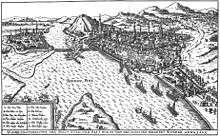
In August 1601, at the Battle of Guruslău, Giorgio Basta and Michael the Brave defeated the Hungarian nobility led by Sigismund Báthory, who accepted Ottoman protection. After the assassination of Michael the Brave by mercenary soldiers under Basta's orders,[19] the Transylvanian nobility, led by Mózes Székely, was again defeated at the Battle of Braşov in 1603 by the Habsburg Empire and Wallachian troops led by Radu Şerban. Hence, the Austrians seemed to be able to win a decisive victory.
The last phase of the war (from 1604 to 1606) corresponds to the uprising of the Prince of Transylvania Stephen Bocskay. When Rudolf – mostly based on false charges – started prosecutions against a number of noble men in order to fill up the court's exhausted treasury, Bocskay, an educated strategist, resisted. He collected desperate Hungarians together with disappointed members of the nobility to start an uprising against the Habsburgs ruler. The troops marched westwards, supported by the Hajduk of Hungary, won some victories and regained the territories that had been lost to the Habsburg army until Bocskay was first declared the Prince of Transylvania (Târgu Mureș, February 21, 1605) and later also to Hungary (Szerencs, April 17, 1605). The Ottoman Empire supported Bocskay with a crown that he refused (being Christian). As Prince of Hungary he accepted negotiations with Rudolf II and concluded the Treaty of Vienna (1606).
Aftermath
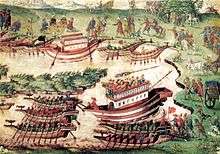
The Long War ended with the Peace of Zsitvatorok on November 11, 1606, with meagre territorial gains for the two main empires—the Ottomans won the fortresses of Eger, Esztergom and Kanisza, but gave the region of Vác (which they had occupied since 1541) to Austria. The treaty confirmed the Ottomans' inability to penetrate further into Habsburg territories. It also demonstrated that Transylvania was beyond Habsburg power. Though Emperor Rudolf had failed in his war objectives, he nonetheless won some prestige thanks to this resistance to the Turks and by presenting the war as a victory. The treaty stabilized conditions on the Habsburg–Ottoman frontier. Also, while Bocskay managed to retain his independence, he also agreed to give up the title of "king of Hungary".
Battles
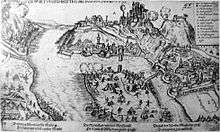
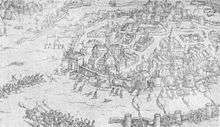
- Sisak
- Veszprém
- Tata (1)
- Székesfehérvár (1)
- Romhány
- Banat
- Győr (1)
- Călugăreni
- Giurgiu
- Esztergom
- Brest
- Eger
- Keresztes
- Herzegovina
- Tata (2)
- Győr (2)
- Buda (1)
- Şelimbăr
- Kanizsa
- Mirăslău
- Guruslău
- Székesfehérvár (2)
- Braşov
- Buda (2)
References
- Csorba, Csaba; Estók, János; Salamon, Konrád (1998). Magyarország Képes Története. Budapest: Hungarian Book-Club. ISBN 963-548-961-7. 62.-64. p.
- A Global Chronology of Conflict: From the Ancient World to the Modern Middle East, Spencer C. Tucker, 2009, p.547
- Attila Weiszhár -Balázs Weiszhár : Csaták kislexikona (Small lexicon of the Battles), Maecenas Publisher 2000. ISBN 963-645-080-3
- The Encyclopaedia of Islam Vol 6 Mahk-Mid p. 1030
- Ervin Liptai: Magyarország hadtörténete I. 1984. ISBN 963-326-337-9
- Zsigmond Pach: Magyarország története 1526–1686, 1985. ISBN 963-05-0929-6
- Cathal J. Nolan (2006). The age of wars of religion, 1000–1650: an encyclopedia of global warfare and civilization. Greenwood Publishing Group. p. 846. Retrieved 2012-03-23.
- Rajko L. Veselinović (1966). (1219-1766). Udžbenik za IV razred srpskih pravoslavnih bogoslovija. (Yu 68-1914). Sv. Arh. Sinod Srpske pravoslavne crkve. pp. 70–71.
- Nikolaj Velimirović (January 1989). The Life of St. Sava. St. Vladimir's Seminary Press. p. 159. ISBN 978-0-88141-065-5.
- Editions speciales. Naučno delo. 1971.
- Mugnai, Bruno; Flaherty, Christopher (2014). Der Lange Türkenkrieg (1593-1606): The long Turkish War, Vol. 1 (Ebook). Soldiershop Publishing. ISBN 9788896519912, p. 67
- Braudel, Fernand (1995). The Mediterranean and the Mediterranean World in the Age of Philip II, Volume 2. Berkeley: University of California Press. ISBN 0520203305, p. 1229
- Hutton, William Holden (1900): Constantinople: the story of the old capital of the empire. London: J.M. Dent & Co, p. 172.
- Teneti, Alberto (1967). Piracy and the Decline of Venice, 1580-1615. Berkeley: University of California Press, p. 47
- Constantin C. Giurescu, Istoria Românilor. Bucharest: Editura All, 2007 (Romanian), p. 183.
- Coln, Emporungen so sich in Konigereich Ungarn, auch in Siebenburgen Moldau, in der der bergischen Walachay und anderen Oerten zugetragen haben, 1596
- Marco Venier, correspondence with the Doge of Venice, 16 July 1595
- Florin Constantiniu, "O istorie sinceră a poporului român", ISBN 973-8240-67-0. Bucharest: Editura Univers Enciclopedic, 2002 (Romanian), p. 128-129.
- Encyclopaedia Britannica.
Sources
- Finkel, Caroline (1988). The Administration of Warfare: The Ottoman Military Campaigns in Hungary, 1593-1606. Vienna: VWGÖ. ISBN 3-85369-708-9.
- Ćirković, Sima (2004). The Serbs. Malden: Blackwell Publishing.CS1 maint: ref=harv (link)
| Wikimedia Commons has media related to Long Turkish War. |
